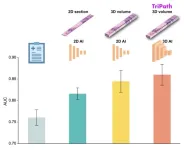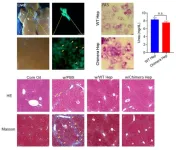(Press-News.org) People with limited English proficiency have a worse experience with virtual healthcare visits than those who are proficient in English, according to a new study led by a team of investigators at Brigham and Women’s Hospital, a founding member of the Mass General Brigham healthcare system. The study highlights the importance of designing telehealth platforms and processes that better serve people who face day-to-day language barriers.
The study, published in JAMA Network Open, analyzed results of the 2021 California Health Interview Survey of 24,453 patients, 9% of whom identified as having limited English proficiency. The survey was conducted in six languages.
People with limited English proficiency were about 40% more likely than those proficient in English to rate video health care visits as worse than in-person health care appointments. They were 20% more likely to describe their experiences with healthcare phone visits as worse than in-person visits, though this finding was not statistically significant.
“Setting up a video visit can require high-speed internet and a device. It may require creating a login for a new platform. If you’re someone with limited English proficiency, you might need an interpreter to be involved. There are a lot of different pieces to navigate,” said lead author Jorge Rodriguez, MD, a clinician-investigator in the Brigham’s Division of General Internal Medicine and Primary Care. “If you're a patient who doesn't speak the language that the technology is built in, just getting onto the platform is challenging.”
Previously published studies have shown that marginalized groups are less likely to have access to virtual care to begin with. The Brigham study found this as well; 37% of patients with limited English proficiency reported having used telehealth services, compared to 50% of the patients who identified as being proficient in the English language.
What is unique about the JAMA Network Open analysis is that it revealed that even when people with limited English proficiency do gain access to virtual care, their experiences are, generally, worse than the experiences of those who don’t face language barriers.
Rodriguez said survey respondents may have rated their experiences with phone visits as better than with video visits because phone calls are less challenging to set up than video calls. Plus, clinical teams may find it easier to call into an interpreting service than it is to add an interpreter to a video call.
Beyond causing frustration, having a poor experience with a telehealth visit could affect health outcomes. For example, someone who has a poor experience with a video visit may be more reluctant to book healthcare appointments in the future. “The findings have implications from a patient satisfaction and patient engagement standpoint that could have implications for health care access and uptake of technology in general,” explained Rodriguez.
To bridge the gap between marginalized patients’ experiences of telehealth versus in-person care, Rodriguez recommended national efforts to expand internet, computer, and smart phone access, video platforms that are simple to navigate in any language, and systems that facilitate a seamless access to interpreters. Rodriguez added that a more immediate solution is multilingual digital navigators who can, over the phone or in person, help patients register for video platforms, respond to technical problems, and more.
Mass General Brigham has implemented a Digital Access Coordinator program, which is part of the United Against Racism initiative. The DAC program helps patients navigate Patient Gateway, telehealth and other digital tools. Its digital team has also made it possible for clinicians to add a virtual interpreter into an Epic integrated virtual visit.
Authorship: In addition to Jorge Rodriguez, Brigham authors of the study include Stuart Lipsitz, David Bates, and Lipika Samal. Additional authors include Elaine Khoong and Courtney Lyles.
Paper cited: Rodriguez, J. et al. “Telehealth experience among patients with limited English proficiency.” JAMA Network Open. DOI: 10.1001/jamanetworkopen.2024.10691
Disclosures: Dr Rodriguez received grants from National Institute on Minority Health and Health Disparities (NIMHD) during the conduct of the study. Dr Lyles received equity from Google Health outside the submitted work. Dr Bates received personal fees from CDI Negev; equity from ValeraHealth, Clew, MDClone, and FeelBetter; and personal fees and equity from AESOP and Guided Clinical Solutions outside the submitted work and holds a patent for PHC-028654 issued Brigham and Women’s Hospital Intraoperative clinical decision support.
Funding: This study was supported by a grant from the NIMHD (K23MD016439).
END
Study finds patients with limited English proficiency have poorer experiences with virtual health care
An analysis led by researchers at Brigham and Women’s Hospital shows people with limited English proficiency are more likely than those proficient in English to have worse experiences with video visits, compared to in-person visits
2024-05-09
ELSE PRESS RELEASES FROM THIS DATE:
Declination of treatment, racial and ethnic disparity, and overall survival in patients with breast cancer
2024-05-09
About The Study: This cross-sectional study highlights racial and ethnic disparities in treatment declination and overall survival, suggesting the need for equity-focused interventions, such as patient education on treatment benefits and improved patient-clinician communication and shared decision-making, to reduce disparities and improve patient survival.
Corresponding Author: To contact the corresponding author, Dezheng Huo, M.D., Ph.D., email dhuo@bsd.uchicago.edu.
To ...
Place-based measures of inequity and vision difficulty and blindness
2024-05-09
About The Study: Residential measures of inequity through segregation, income inequality, or persistent poverty were associated with a greater number of residents living with vision difficulty and blindness in this cross-sectional study. It is essential to understand and address how neighborhood characteristics can impact rates of vision difficulty and blindness.
Corresponding Author: To contact the corresponding author, Patrice M. Hicks, Ph.D., M.P.H., email pmhicks@med.umich.edu.
To access the embargoed study: Visit our For The Media website at this link https://media.jamanetwork.com/
(doi:10.1001/jamaophthalmol.2024.1207)
Editor’s ...
AI advancements make the leap into 3D pathology possible
2024-05-09
Researchers developed Tripath to bridge computational gaps to process 3D tissue and predict outcomes based on 3D morphological features
Cancer recurrence models trained on 3D tissue volumes outperformed models trained on 2D tissue images
Human tissue is intricate, complex and, of course, three dimensional. But the thin slices of tissue that pathologists most often use to diagnose disease are two dimensional, offering only a limited glimpse at the tissue’s true complexity. There is a growing push in the field of pathology toward examining tissue in its three-dimensional form. But 3D pathology datasets can contain hundreds of times more data than their 2D counterparts, ...
Net zero plans show limited climate ambition on ‘residual’ emissions
2024-05-09
New research by the University of East Anglia (UEA) reveals what countries think will be their most difficult to decarbonise sectors when they reach net zero, with agriculture expected to be responsible for the largest remaining emissions.
Once countries have taken the ‘easy’ steps to get to net zero - such as switching to more renewable electricity, electric cars, and heat pumps for homes - they are still left with some sources of emissions.
These ‘residual’ emissions continue to be emitted at the ...
New Rhizobia-diatom symbiosis solves long-standing marine mystery
2024-05-09
Nitrogen is an essential component of all living organisms. It is also the key element controlling the growth of crops on land, as well as the microscopic oceanic plants that produce half the oxygen on our planet. Atmospheric nitrogen gas is by far the largest pool of nitrogen, but plants cannot transform it into a usable form. Instead, crop plants like soybeans, peas and alfalfa (collectively known as legumes) have acquired Rhizobial bacterial partners that “fix” atmospheric nitrogen into ammonium. This partnership makes legumes one of the most important ...
New stem cell research may have implications for liver transplantation
2024-05-09
Liver disease, due to viral infections, alcohol abuse, obesity, or cancer, accounts for 1 in every 25 deaths worldwide. A liver transplant can be life saving for people with end-stage liver disease. However, the procedure has limitations related to donor shortage, a technically challenging and invasive surgical procedure, and the requirement for lifelong immunosuppressive medication in the transplant recipients. An alternative to whole organ transplantation is the less invasive injection of dissociated human liver cells, but donor shortage is still an issue. Utilizing ...
New cells could be key to treating obesity
2024-05-09
Understanding how fat tissue forms and functions is crucial for addressing obesity and related metabolic diseases. However, adipose tissue, or body fat, behaves differently based on its location in the body.
Take, for example, the omentum: a large, apron-like fatty tissue hanging from the stomach that covers organs within the peritoneum, such as the stomach and intestines. It not only stores fat but also plays roles in immune regulation and tissue regeneration.
Omental adipose tissue is associated with ...
Supercharging immune cells to battle blood cancer: Breakthrough in cancer immunotherapy
2024-05-09
A new study reveals a groundbreaking approach to immunotherapy, demonstrating that blocking the interaction between the CD300A receptor and phosphatidylserine (PS) significantly enhances the ability of human natural killer (NK) cells to lyse hematologic malignancies (HMs).
Cancer has a profound impact on human life, and immune checkpoint therapy (ICT) has made remarkable strides in cancer treatment. However, ICT faces challenges such as low overall response rates and the emergence of immune-related adverse events. To overcome these hurdles, researchers are exploring new immune checkpoints. CD300A, a type-I transmembrane protein with immunoreceptor tyrosine-based inhibitory ...
Liberals and conservatives differ on climate change beliefs—but are relatively united in taking action
2024-05-09
The division between liberals and conservatives on both climate-change beliefs and related policy support is long-standing. However, the results of a newly released global experiment show that despite these differences, the two camps actually align when it comes to taking certain actions to combat climate change.
The study, led by researchers at New York University, finds that when given the opportunity, liberals and conservatives take action to address climate change at roughly the same levels—and that ...
Biogeographical evidence shows trickster animal folklore limited by environmental factors
2024-05-09
Humans have the capacity to imagine civilizations and creatures that have never existed, and our language reflects that ability. It would therefore be understandable if the stories we tell ourselves stretched beyond the bounds of local ecology. However, research has shown that many cultural artifacts and ideas are strongly affected by environmental factors.
Researchers in Japan wanted to know if the biogeography of a region could constrain motifs in animal folklore. To do this, they studied the distribution of animal trickster folklore against the distribution of the animal the folklore ...
LAST 30 PRESS RELEASES:
The perfect plastic? Plant-based, fully saltwater degradable, zero microplastics
Bias in data may be blocking AI’s potential to combat antibiotic resistance
Article-level metrics would provide more recognition to most researchers than journal-level metrics
Satiety’s little helper: Protein that supports appetite regulating protein identified
UF dives deep into predicting storm damage with computer models
A stormy ocean voyage yields insights on the global carbon cycle
Scientists identify first non-coding gene that controls cell size
Demonstration of altermagnetism in RuO₂ thin films -- A new magnetic material for the AI era
Penn researchers awarded $25M to conduct trial using smartphones to fight heart disease
PCORI awards funding for new patient-centered healthcare research
Exploring the origins of the universe: 145 low-noise amplifiers complete ALMA telescopes
Empress cicada wings help illuminate molecular structure
Using sound waves to detect helium
Time burden in patients with metastatic breast and ovarian cancer from clinic and home demands
Researchers discover bias in AI models that analyze pathology samples
Scientists ID potential way to prevent brain injuries from triggering Alzheimer's
MASTER 2nd Open Call: Execution period kick-off
Algae for health in food and pharma
Advanced microrobots driven by acoustic and magnetic fields for biomedical applications
Chicago health information leader recognized for raising CPR readiness and blood pressure awareness
The Intimate Animal, a new book from Kinsey Institute Executive Director Dr. Justin Garcia
When blue-collar workers lose union protection, they try self-employment
New video dataset to advance AI for health care
MEA-based graph deviation network for early autism syndrome signatures in human forebrain organoids
New modeling approach sheds light on rare gut disease
Study documents potentially hazardous flame retardants in firefighter gear
Can certain bacteria regulate aging of the immune system and its related alterations?
AI model helps diagnose often undetected heart disease from simple EKG
There are fewer online trolls than people think
Cell membrane fluctuations produce electricity
[Press-News.org] Study finds patients with limited English proficiency have poorer experiences with virtual health careAn analysis led by researchers at Brigham and Women’s Hospital shows people with limited English proficiency are more likely than those proficient in English to have worse experiences with video visits, compared to in-person visits





